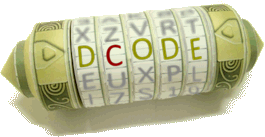Tool to convert wavelength to visible color, understand the light spectrum, interpret light in nanometers and identify associated colors.
Color Wavelength - dCode
Tag(s) : Physics-Chemistry
dCode is free and its tools are a valuable help in games, maths, geocaching, puzzles and problems to solve every day!
A suggestion ? a feedback ? a bug ? an idea ? Write to dCode!
Color Wavelength
Wavelength to Color Converter
Color to Wavelength Converter
Answers to Questions (FAQ)
What is a color wavelength? (Definition)
Wavelength is a physical quantity expressed in nanometers (nm) that corresponds to the distance between two successive peaks of an electromagnetic wave.
In the visible light spectrum, it determines the color perceived by the human eye.
The visible spectrum generally extends from 380 nm (violet) to 780 nm (red).
How to convert a wavelength to visible color?
To translate a value in nanometers (nm) into color on a screen (composed of Red, Green, and Blue), there is no real formula because colors can be perceived slightly differently by the human eye. However, there is a consensus on the approximate wavelengths of the visible electromagnetic spectrum:
— 380–450 nm (Violet/Blue)
— 450–495 nm (Blue/Cyan)
— 495–570 nm (Green)
— 570–590 nm (Yellow)
— 590–620 nm (Orange)
— 620–780 nm (Red)
The boundaries between the transitions from one color to another are not exactly defined.
Why do some colors not have a well-defined wavelength?
Some colors don't have an exact wavelength because they don't correspond to monochromatic light (i.e., a single wavelength).
Example: Pink/Magenta: result from a mixture of red and blue
Example: Gray, white, black: result from the luminance or absence of light
Example: Brown/Tan: dark, desaturated form of an orange or red hue
In these cases, color being absent from the luminous spectrum, dCode tries to offer the closest colors (delta E distance)
Who discovered the relationship between color and wavelength?
The relationship between color and wavelength was formalized in the 18th century with Newton's work on light and the prism. Modern scientific foundations date from the 19th century with James Clerk Maxwell and the development of electromagnetic theory.
What are ultraviolet and infrared?
Outside the visible spectrum (below 380 nm or above 780 nm), the human eye does not perceive color, so no actual color can be displayed (black?).
UV (ultraviolet) corresponds to wavelengths below 380 nm (invisible to the naked eye).
Visible light is between 380 and 780 nm.
IR (infrared) corresponds to wavelengths above 780 nm (invisible to the naked eye).
Source code
dCode retains ownership of the "Color Wavelength" source code. Any algorithm for the "Color Wavelength" algorithm, applet or snippet or script (converter, solver, encryption / decryption, encoding / decoding, ciphering / deciphering, breaker, translator), or any "Color Wavelength" functions (calculate, convert, solve, decrypt / encrypt, decipher / cipher, decode / encode, translate) written in any informatic language (Python, Java, PHP, C#, Javascript, Matlab, etc.) or any database download or API access for "Color Wavelength" or any other element are not public (except explicit open source licence). Same with the download for offline use on PC, mobile, tablet, iPhone or Android app.
Reminder: dCode is an educational and teaching resource, accessible online for free and for everyone.
Cite dCode
The content of the page "Color Wavelength" and its results may be freely copied and reused, including for commercial purposes, provided that dCode.fr is cited as the source (Creative Commons CC-BY free distribution license).
Exporting the results is free and can be done simply by clicking on the export icons ⤓ (.csv or .txt format) or ⧉ (copy and paste).
To cite dCode.fr on another website, use the link:
In a scientific article or book, the recommended bibliographic citation is: Color Wavelength on dCode.fr [online website], retrieved on 2025-12-20,
